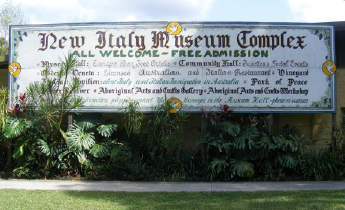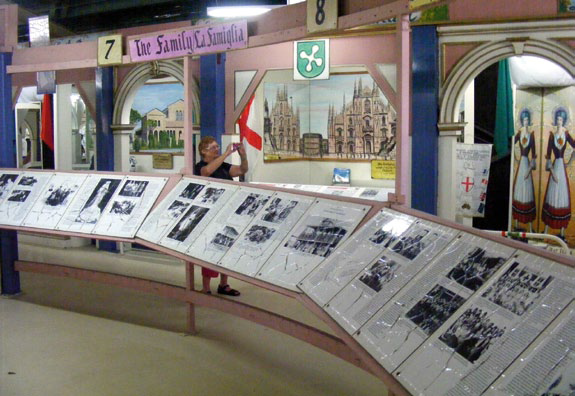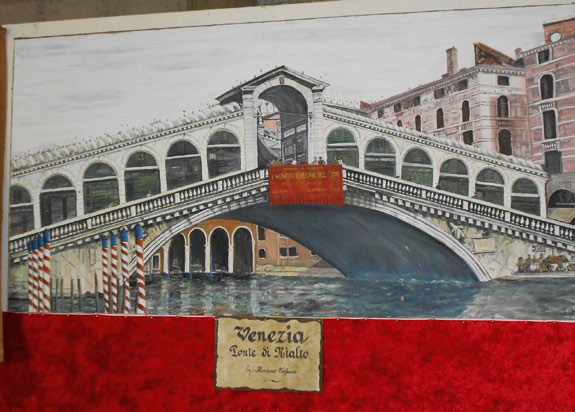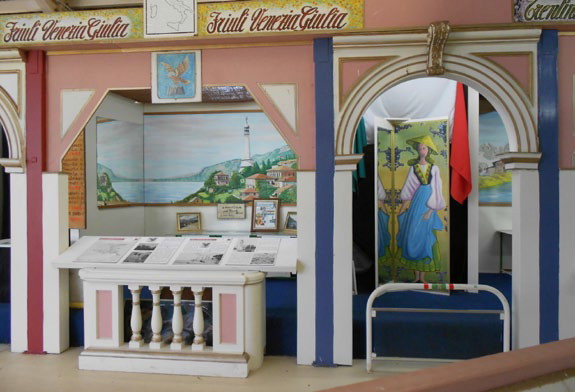
Whilst travelling the Pacific Highway just south of Woodburn and 83 kilometres north of Grafton, we took a break to check out the New Italy Museum. From the road all that can be seen is a picnic area with buildings behind it, but what a surprise awaited us!
There were two museums: the New Italy Museum and the Italian Pavilion.
Between these two buildings was a lovely garden with some beautiful sculptures. After walking around the garden we entered the New Italy Museum. The displays included the historical facts about the original families who settled here from 1882, plus photographs, farming equipment, household items, food, clothing, church altar and organ; a wonderful ‘step back in time’.
The following is some of the historical information gained from my visit to the New Italy Museum.
Fifty families from Veneto in Northern Italy boarded the India in Barcelona in July 1880 to sail for Port Breton (called ‘The Promised Land’), between New Britain and New Ireland. Named La Nouvelle France (an imaginary Kingdom in the Bismarck Archipelago) instead of finding a thriving settlement, a wall of jungle vegetation and disease was discovered.
For months the Italian families struggled through the constant rain and impenetrable vegetation, struggling to find food and create shelter. Many deaths occurred. The survivors petitioned the captain of the India who took them to Noumea, but their new location proved unsuitable as it was a penal colony. The India was declared unseaworthy and the emigrants were stranded.
The Italian Consul in Australia heard of their fate and requested assistance from Sir Henry Parkes (the Premier of NSW) who chartered the James Paterson to bring the survivors to Sydney. They arrived on the 7th April, 1881, destitute and in poor health.
The Italian families were determined to form a settlement together because they had the skills necessary for a self-sufficient community. The government decided that in view of their weakness and poverty, it would be more beneficial to hire them to employers for the first 12 months. The Sydney Morning Herald advertised that the Italian families would be hired for 12 months for 30 pounds. They were hired to English speaking employers and dispersed throughout the colony in an attempt to force their rapid assimilation into the Australian culture. The families were separated.
After a year, hearing of land selections available in the Richmond River District, near Woodburn, Northern NSW, the first settlers moved onto land that had no running water or creeks. Good water was found 8-12 feet down, so wells were built from rocks and timber. Today Antonioni’s Well, an original circular stone lined well, amongst other wells, is still conserved within the boundaries of New Italy and all have significant archaeological significance.

Scrub was cleared for agricultural needs and buildings. These buildings were built from local materials and all had earthen floors. Men, women and children planted fields with crops and vegetable gardens and from sheer hard work turned cold and baron soil into land able to support and yield a crop. Sweet potatoes grew profusely and they were able to live off these. By 1889 nearly every household had up to 2 ½ acres under grapes.
As their land was too poor for sustainable agriculture the men had to leave for months at a time to work in canefields and sugar mills, leaving the women to tend the crops. They worked at many things to survive. A timber mill was built at New Italy, then moved to Moonem to be close to the river transport and for nearly three decades timber remained the major industry for New Italy.

During the 1890s cream was collected from New England twice a week in winter and every other day in summer, the cream was then taken by sleigh to Moonem on the Bungawalbin Creek and on to the Coraki Cream Factory. Cows did not survive for long in New Italy due to the lack of lime in the soil.

One unusual but thriving industry became the occupation of women and children in the silk industry (sericulture) and the breeding of silkworms. Land was cleared for mulberry trees and silkworms were reared in sheds, kitchens, bathrooms, bedrooms, anywhere under cover. New Italy won awards at trade fairs in Chicago and Milan. Unfortunately, a devastating fire, which began in a kitchen, ravaged the entire community and finished the silk industry within New Italy.
The name New Italy was adopted when an application was submitted for a school at the settlement. The application required an official name for the school, which was opened in 1885. The New Italy School closed in 1933.
One of the worst droughts on record on the North Coast during the 1890s and the first decade of the 1900s resulted in the younger people leaving for richer farmlands.
Having absorbed the history of the early settlers, it was time for a coffee break, snack and relaxation in the Tastes of New Italy Café before checking out more modern times in The Italian Pavilion.
In 1989 the Italian Government officials presented part of the structure of the Italian Pavilion building used at the World Expo’ 88 in Brisbane to New Italy. Volunteers brought the materials down in many truck loads and rebuilt the structure. In 1993, the newly built Italian Pavilion was officially opened. The exhibitions included representations of the 20 Italian provinces, histories of Italian settlement in Australia and in particular, stories of the extensive Italian settlement on the North Coast of NSW. It also opens a window into Italy of yesteryear and today.
Housed in this beautiful building are spectacular paintings, murals, sculptures, all exhibited in individual displays reflecting the regions in Italy and made this a really incredible place to visit. After checking out all the exhibits we sat in comfortable chairs to watch DVDs on the history of the Italian families.
Celebrations are held every year to commemorate Australia Day and on April 7, members of pioneer families assemble in the Park of Peace for a special ceremony for Migrants, Arrival and Descendants’ Day.
The New Italy is a non-profit organisation and entry to the New England Museum is free. The Museum relies on membership fees, donations and the work of the volunteers for the ongoing maintenance and general day to day operations.
For more information please visit: www.newitaly.com.au
Category: Destinations
Written: Mon 01 Apr 2013
Printed: April, 2013
Published By: